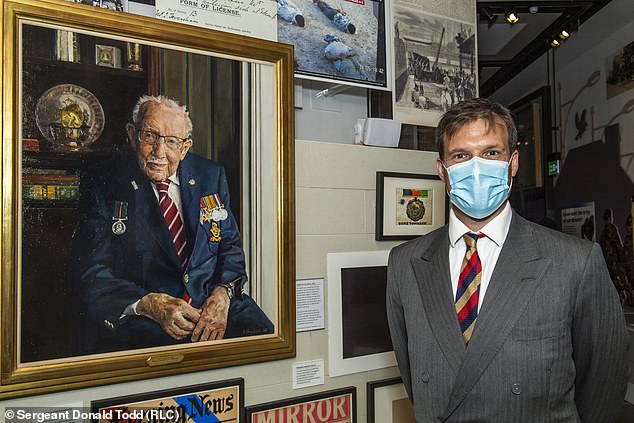The first official portrait of Burma veteran Captain Sir Tom Moore has been unveiled at the National Army Museum before the 75th anniversary of Victory in Japan Day.
Saturday is VJ Day, marking 75 years since Emperor Michinomiya Hirohito announced the unconditional surrender of his Imperial forces.
Ahead of the anniversary, artist Alexander Chamberlain, a former cavalry officer, has raised awareness of the Fare East campaign by creating an oil painting of Sir Tom, who raised more than £32million for the NHS at the height of the coronavirus pandemic.
Alexander Chamberlin painted Captain Sir Tom Moore to commemorate the 75th anniversary of Victory in Japan Day

Captain Sir Tom Moore recently shared his memories of fighting in Burma ahead of VJ Day, revealing he carried a suicide pill at all times, in case he was captured by Japanese forces
The centenarian is depicted in his Duke of Wellington’s Regiment blazer and tie, proudly wearing his medals which include the Burma Star, the Defence Medal, the War Medal 1939-45 and the 1939-45 Star.
Following his phenomenal fundraising efforts earlier this year, Sir Tom was awarded the Yorkshire Regiment Medal and a gold Blue Peter badge, which are also included in the painting.
Speaking about meeting Sir Tom, Mr Chamberlin told the BBC: ‘It was amazing. Him and his grandson Benji were incredibly accommodating.

The oil painting of Captain Sir Tom Moore now hangs in the National Army Museum in Chelsea
‘It was very exciting to get him in a place where he was most relaxed, it really helped getting the image across.’
The artist hopes the portrait will raise awareness of soldiers who fought in the Far East.
Ahead of VJ Day tomorrow, Sir Tom shared memories from his time in Burma, modern day Myanmar, including how at the age of just 22, he caught dengue fever and carried a suicide pill should he be captured by the Japanese.
He told Radio Times: ‘I wasn’t very scared. Not really. At one stage we were given a pill that, well, it did you in completely.
‘That was to swallow in case we were captured and forced to give up information.
He added: ‘In Burma I never thought of disaster. I always thought we would win and looked forward to the time when we would keep the flag flying in peace.’

Sir Tom told Radio Times: ‘In Burma I never thought of disaster. I always thought we would win and looked forward to the time when we would keep the flag flying in peace’
Speaking on ITV documentary Captain Tom’s War, he said: ‘I was with the front of the Indian army, we all battled together.
‘We were under fire constantly, there was an element of discomfort.
‘I was only 21 or 22, you don’t get very frightened at 22.’
One million Allied troops from 40 countries attempted to repel Imperial Japan from Burma over almost three years, between 1942 and 1945.
Speaking of the Japanese fighters, he recalled: ‘They were quite a formidable force because there were people who didn’t mind if they died’.
He added: ‘They were awful, they were what we say, were completely without morals. They starved people to death and didn’t care. That was bad.’
Plans to commemorate the anniversary have been scaled back because of Covid-19.
Prince Charles and Camilla will lead the nation in a two-minute silence held at the National Memorial Arboretum in Staffordshire.
Among those at the event will be 93-year-old Albert Wills, who served in the Far East aboard HMS Indefatigable.
The Red Arrows will also conduct a nationwide flypast, routing over Edinburgh, Belfast, Cardiff and London – including flying over head the Royal Hospital in Chelsea.
Prime Minister Boris Johnson said: ‘When the Second World War ended 75 years ago with the surrender of Japan, British soldiers, sailors and airmen were serving in the Far East, fighting hard to achieve victory – and were among the last to come home.
‘On this anniversary I want to remember what we owe the veterans of the Far East campaign. They brought an end to the Second World War, they changed the course of history for the better, liberated South East Asia, and many paid the ultimate sacrifice.
‘That’s why on this remarkable anniversary – and every day hereafter – we will remember them.’
